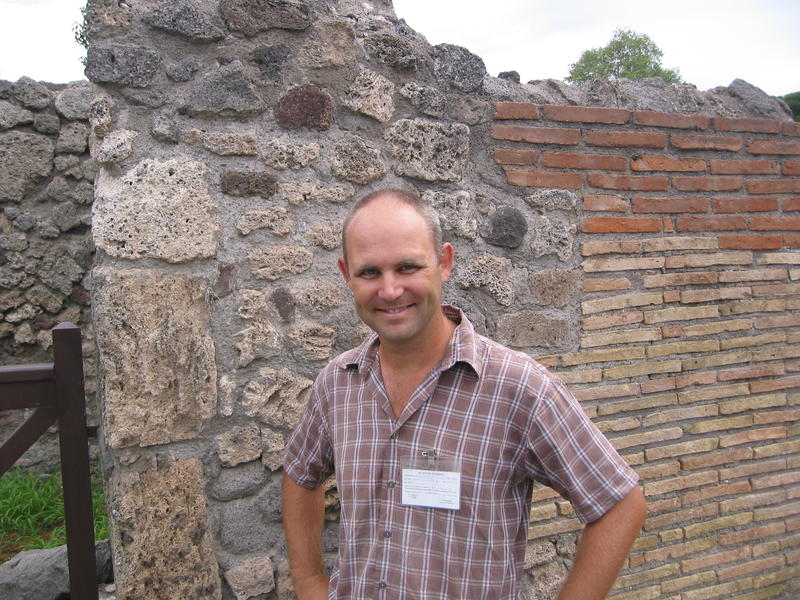Affiliation: University of Cincinnati

Steven Ellis is with the Department of Classics at the University of Cincinnati, and holds his Ph.D. from the University of Sydney. His areas of specialization include Roman urbanism and social history, ancient architecture, Greek and Roman art and archaeology, and the excavation of complex urban sites; his is the project director for the Pompeii Archaeological Research Project at Porta Stabia, and the East Isthmia Archaeological Project. Professor Ellis has published widely, and has several recent forthcoming works on aspects of his work in Pompeii.
Roman cities present a patchwork of socio-economic contrast, with enormous civic monuments mixed among more modest spaces from shops to sewers, not to mention every manner of house big and small. Whether through scale, or the diversity of the parts, even the most poorly preserved Roman cities can overwhelm our best efforts to understand their urban and social textures. This presentation explores various approaches to defining and understanding the social character and development of Roman neighborhoods, drawing on the recent excavations of the Porta Stabia neighborhood at Pompeii. These excavations, under the auspices of the University of Cincinnati and the American Academy in Rome, targeted two town blocks of the city, as well as several adjacent, civic structures (the fortification wall and gate, the streets, and the Quadriporticus); the excavations covered more than ten separate building plots (c. 4000m2) made up of shops, houses, and hospitality establishments. This ‘behind-the-scenes’ view of the latest excavations at Pompeii opens up an entirely new perspective on the city, with a special focus on the lives and livelihoods of the Pompeian sub-elite.
Short bibliography and/or website on lecture topic:
Ellis, Steven J.R., 2018, The Roman Retail Revolution. Oxford University Press.
This presentation dives deep into the social and economic worlds of the Roman shop. As the most common form of any singular type of Roman building, shops were at once a vital fixture in the operation of a Roman city: they were omnipresent along all of the busiest roads, and gathered in number at street intersections and other central locations. But what do we really know about the place of Roman shops and bars in all of this urban system? And how can we better understand how they were used by those on either side of the shop counter? In order to throw some new light on the formation of Roman retail landscapes, a new kind of socio-economic framework is offered to understand the motivations behind urban investment in Roman shops. Their historical development is also unraveled to identify three major waves – or, revolutions – in the shaping of retail landscapes. The presentation features two entirely new bodies of evidence. The first is generated from the University of Cincinnati’s recent archaeological excavations into a Pompeian neighborhood of close to 20 shop-fronts. The second comes from the presenter’s field-survey of the retail landscapes of more than 100 cities from across the full breadth of the Roman world. The richness of this information, combined with an interdisciplinary approach to the lives of the Roman sub-elite, results in a refreshingly original look at the history of retailing and urbanism in the Roman world.
Short bibliography and/or website on lecture topic:
Ellis, Steven J.R., 2018, The Roman Retail Revolution. Oxford University Press.
In this presentation we take a ‘behind-the-scenes’ tour of the latest (and still ongoing) excavations of the Punic and Roman city of Tharros, on the west coast of Sardinia. Considered one of the most spectacular archaeological sites in the Mediterranean, perched as the city is along a narrow peninsular into the sea, Tharros has long attracted visitors to its shores, from Phoenicians and Carthaginians to Romans and Spaniards, all of them taking advantage of its prime location and protected harbor. As a commercial center, Tharros serviced one of the most important trading routes of the Mediterranean, that between Carthage and Marseille. Early results from the excavations by the University of Cincinnati show that this movement of people and material made an important impact on the livelihoods of the town’s local inhabitants; new foods were consumed, new cultural customs were adopted, and new ideas in architecture were developed. But these discoveries are so new that the presentation is less about showcasing results and answers as it is about exploring the various ways in which the team is approaching an archaeological excavation of this type, one that is focused on questions of the social and structural making of a long-lived city. Paired as the project is with Cincinnati’s excavations at Pompeii, the presentation will also examine the extent to which two related projects of two different cities can connect both information and methodologies to help form a richer understanding of Roman urbanization.